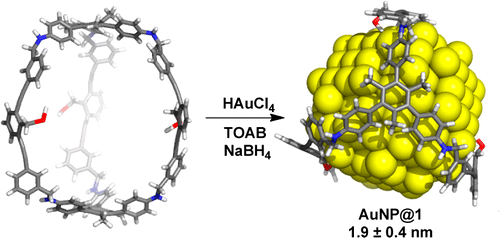McCaffrey, R.; Long, H.; Jin, Y.; Sanders, A.; Park, W.; Zhang, W. J Am Chem Soc 2014, ASAP.
DOI: 10.1021/ja412606t
We report a novel strategy for the controlled synthesis of gold nanoparticles (AuNPs) with narrow size distribution (1.9 ± 0.4 nm) through NP nucleation and growth inside the cavity of a well-defined three-dimensional, shape-persistent organic molecular cage. Our results show that both a well-defined cage structure and pendant thioether groups pointing inside the cavity are essential for the AuNP synthesis.
As the size of the material gets smaller and approaches the nanoscale, some of those intensive properties do, indeed, change. Therefore, properties can no longer be categorized without qualification as those that do change (extensive) and those that do not (intensive) because all properties can change depending on scale. For instance, spheres of gold with diameters of 1 m, 1cm and 1 mm will all be shiny and goldcolored, and will exhibit metallic properties such as malleability and conductivity. On the macroscale, all of these properties remain the same. However, when spheres of gold become very small, those properties change. On the nanoscale, the color of gold particles becomes very sensitive to size. Gold spheres with a diameter of 13 nm suspended in solution (a colloidal solution) afford a red color. At sizes less than 10 nm, gold loses its metallic properties and is no longer able to conduct electricity. Threfore, studying a variety of size-dependent phenomenon where finite size effects become important.
Size-dependent optical properties of gold nanoparticles[1]
In this paper, Zhang and coworkers in University of Colorado ave demonstrated a cage (showing in top images)-templated strategy for the controlled synthesis of AuNPs through the use of a well-defined, discrete organic molecular cage functionalized with pendant interior thioether groups. The AuNPs formed inside the cage cavity exhibit narrow particle size distribution (1.9 ± 0.4 nm) and could potentially be used as seed particles for further seed-mediated growth of nonspherical Au nanocrystals.
-
References
[1] “Nanostructures in Biodiagnostics ”
Rosi, N. L.; Mirkin, C. A. Chem Rev 2005, 105, 1547. DOI:10.1021/cr030067f
-
Related Links
-
Related Books
[amazonjs asin=”1848168063″ locale=”US” title=”Gold Nanoparticles for Physics, Chemistry and Biology”][amazonjs asin=”3847371797″ locale=”US” title=”Gold Nanoparticles: Synthesis, Characterization and Immunodiagnostic applications”][amazonjs asin=”1847356435″ locale=”US” title=”Update on Gold Nanoparticles: From Cathedral Windows to Nanomedicine”]



